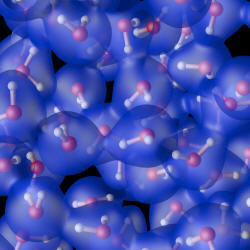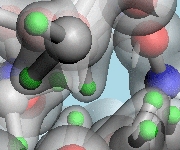Gygi Research Group at UC Davis
Welcome to the Electronic Structure Laboratory at the University of California Davis. Our research focuses on the development of numerical algorithms and high-performance software for electronic structure computations and First-Principles Molecular Dynamics (FPMD) simulations.We are part of the The DOE Midwest Center for Computational Materials (MICCoM) at Argonne National Laboratory MICCoM that develops methods and optimized codes to compute structural, electronic properties, and transport coefficients from atomistic and first principles simulations, integrating ab initio molecular dynamics (MD) with classical and continuum codes. As a member of MICCoM, the UC Davis Electronic Structure Laboratory develops high-performance quantum simulation algorithms and implementations of first-principles molecular dynamics.
News
[2024-08-09] Qbox version 1.78.2 is available at http://qboxcode.org.
[2024-04-05] A paper on the simulation of defects in silicon carbide has appeared, demonstrating the use of the Qbox code in client-server mode for nudged-elastic-band (NEB) calculations:
C. Zhang, F. Gygi and G. Galli, "Charge state and entropic effects affecting the formation and dynamics of divacancies in 3C-SiC",
Phys. Rev. Mat. 8 046201, (2024).
https://doi.org/10.1103/PhysRevMaterials.8.046201
[2023-12-21] A paper on the simulation of an electrified silicon-water interface has appeared, demonstrating the use of the Qbox code in molecular dynamics simulations in the presence of an electric field:
Z. Ye, F. Gygi, G. Galli, "Raman Spectra of Electrified Si-Water Interfaces: First-Principles Simulation",
J. Phys. Chem. Lett. 15, 51 (2024).
https://doi.org/10.1021/acs.jpclett.3c03122
[2023-09-26] A paper on the simulation of spin-defect formation in silicon carbide has appeared,
demonstrating the use of the Qbox code:
C. Zhang, F. Gygi, G. Galli, "Engineering the formation of spin-defects
from first principles",
Nature Communications 14, 5985 (2023).
https://doi.org/10.1038/s41467-023-41632-9
[2022-05-18] A paper on the computation of the free energy of Au clusters has
appeared,
demonstrating the use of the SSAGES software suite coupled with the Qbox code:
J. Shi, S. Huang, F. Gygi, J.K. Whitmer, "Free-Energy Landscape and
Isomerization Rates of Au4 Clusters at Finite Temperatures",
J. Chem. Phys. A 126, 3392-3400 (2022).
https://doi.org/10.1021/acs.jpca.2c02732
[2021-07-26] A paper on the simulation of quantum vibronic effects in
carbon allotropes has appeared, demonstrating the use of Qbox FPMD simulations
coupled to colored-noise thermostats using the
i-PI software:
A. Kundu, M. Govoni, H. Yang, M. Ceriotti, F. Gygi, G. Galli,
"Quantum vibronic effects on the electronic properties of solid and
molecular carbon", Phys. Rev. Mat. 5, L070801 (2022).
https://doi.org/10.1103/PhysRevMaterials.5.L070801.
[2021-04-16] A paper on the simulation of a C-H bond activation is out:
D. Gygi, M. I. Gonzalez, S. J. Hwang, K. T. Xia, Y. Qin, E. J. Johnson, F.
Gygi, Y-S. Chen and D. G. Nocera, “Capturing the Complete Reaction Profile of a
C-H Bond Activation”, J. Am. Chem. Soc. 143, 6060 (2021).
https://doi.org/10.1021/jacs.1c02630.
[2021-03-17] Our paper on coupling Qbox and SSAGES for the free energy
computation of nitrogen dissociation on ruthenium is out:
E. M. Lee, T. Ludwig, B. Yu, A. R. Singh, F. Gygi, J. K. Nørskov and J. J. de
Pablo, "Neural Network Sampling of the Free Energy Landscape for Nitrogen
Dissociation on Ruthenium", J. Chem. Phys. Lett, 12, 2954 (2021).
https://doi.org/10.1021/acs.jpclett.1c00195.
[2021-02-19] Our paper on code interoperability is out:
M. Govoni, J. Whitmer,
J. de Pablo, F. Gygi, G. Galli, “Code interoperability extends the scope of
quantum simulations”, npj Computational Materials 7, 1-10 (2021).
https://doi.org/10.1038/s41524-021-00501-z.
[2020-11-16] Our paper on First-Principles simulations of oxide-water
interfaces is out:
Katherine J. Harmon, Kendra Letchworth-Weaver, Alex P. Gaiduk, Federico Giberti, Francois Gygi, Maria K. Y. Chan, Paul Fenter, and Giulia Galli,
"Validating first-principles molecular dynamics calculations of oxide/water interfaces with x-ray reflectivity data",
Phys. Rev. Mat. 4, 113805 (2020)
https://doi.org/10.1103/PhysRevMaterials.4.113805.
[2020-05-15] Our paper on the dissociation of NaCl is out:
Zhang, C., Giberti, F., Sevgen, E. et al.
"Dissociation of salts in water under pressure"
Nat Commun 11, 3037 (2020).
https://doi.org/10.1038/s41467-020-16704-9.
[2020-02-14] The SG15 pseudopotential collection is available in UPF format at http://quantum-simulation.org/potentials/sg15_oncv
[2020-02-04] Qbox 1.68.2 is available, including the SCAN density functional.
[2019-10-02] The SCAN330 dataset is published with the paper "Ensemble first-principles molecular dynamics simulations of water using the SCAN meta-GGA density functional", J. Chem. Phys. 151, 164101 (2019) https://doi.org/doi/10.1063/1.5124957 (Editor's Pick).
[2018-04-25] Our JCTC paper on coupled Qbox-SSAGES simulations is available at
https://pubs.acs.org/doi/10.1021/acs.jctc.8b00192
[2018-07-28] Qbox online documentation update
See the Qbox home page for details and
documentation.
The SG15 table of ONCV pseudopotentials is available
at www.quantum-simulation.org,
and a full description is given in:
M. Schlipf and F. Gygi, Comput. Phys. Comm. 196, 36-44 (2015).
http://dx.doi.org/10.1016/j.cpc.2015.05.011.
High-Performance First-Principles Molecular Dynamics
In order to enable accurate numerical simulations of atomic-scale properties of matter for applications in chemistry, physics and materials science, we are developing scalable algorithms for First-Principles Molecular Dynamics (FPMD). FPMD combines a quantum-mechanical description of electronic structure with a classical description of statistical properties. Our goal is to efficiently use the power of the largest supercomputers available today to extend the range of applications of FPMD. We develop advanced simulation features such as on-the-fly computation of spectroscopic data and coupling of FPMD simulations with efficient statistical sampling algorithms. Code development is carried out using C++/MPI/OpenMP and targets platforms such as NERSC Perlmutter or ANL Theta. This project is supported by the US Department of Energy Office of Basic Energy Sciences through the MICCoM Computational Materials Science Center.Algorithm research projects
We are developing specialized parallel algorithms to accelerate the most time-consuming steps of electronic structure computations. We explore the problem of data compression for efficient storage of electronic wave function when solving the electronic structure problem, and more generally the problem of generating optimally localized electronic wave functions. This problem is related to algorithms for simultaneous approximate diagonalization of symmetric/hermitian matrices, used in signal processing applications.Qbox project
We develop and support Qbox, a C++/MPI implementation of FPMD for massively parallel computers. Qbox is available in source form under a GPL license. See the Qbox home page.Qbox latest features includes an implementation of Optimized Norm-Conserving Vanderbilt (ONCV) pseudopotentials and the option to include an applied electric field.
Qbox implements the plane-wave, pseudopotential electronic structure method and was designed for scalability on thousands of processors. It has been ported to large parallel platforms, including BlueGene/Q, Cray XT-5, Cray XE-6, and a variety of Linux/Intel clusters. It is currently used in projects involving simulations of liquids, semiconductor nanostructures, and materials science. The paper Large-Scale Electronic Structure Calculations of High-Z Metals on the BlueGene/L Platform was awarded the 2006 ACM/IEEE Gordon Bell Prize for Peak Performance using the Qbox code. The architecture of Qbox is described in the following architecture paper.

